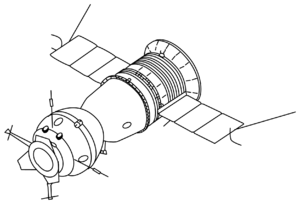 Soyuz 7K-TM Soyuz 7K-TM | |
| Mission type | Orbital test flight |
|---|---|
| Operator | Soviet space program |
| COSPAR ID | 1974-018A |
| SATCAT no. | 7234 |
| Mission duration | 9 days, 21 hours and 35 minutes |
| Spacecraft properties | |
| Spacecraft | Soyuz 7K-TM s/n 71 |
| Manufacturer | NPO Energia |
| Launch mass | 6,570 kg (14,480 lb) |
| Start of mission | |
| Launch date | 3 April 1974, 07:30 (1974-04-03UTC07:30Z) GMT |
| Rocket | Soyuz-U |
| Launch site | Baikonur 31/6 |
| End of mission | |
| Disposal | Deorbited |
| Landing date | 13 April 1974, 05:05 (1974-04-13UTC05:06Z) GMT |
| Orbital parameters | |
| Reference system | Geocentric |
| Perigee altitude | 187 km (116 mi) |
| Apogee altitude | 309 km (192 mi) |
| Inclination | 51.8° |
| Period | 89.4 min |
| Soyuz programme← Soyuz 13Kosmos 656 → Kosmos (satellites)← Kosmos 637Kosmos 639 → | |
Kosmos 638 (Russian: Космос 638) was an uncrewed test of the 1975 Apollo–Soyuz Test Project Soyuz. It carried an APAS-75 androgynous docking system.
This was followed by another uncrewed test of this spacecraft type, Kosmos 672. It was a Soyuz 7K-TM spacecraft.
When the air was released from the orbital module (which is ejected before re-entry of the capsule) it caused unexpected motions with the spacecraft. This led to the next test also being uncrewed.
Mission parameters
- Spacecraft: Soyuz-7K-TM №71
- Mass: 6510 to 6680 kg
- Crew: None
- Launched: April 3, 1974
- Landed: April 13, 1974
See also
References
- ^ David S. F. Portree (1995). Mir Hardware Heritage (PDF). NASA. NASA-SP-4225. Archived (PDF) from the original on 26 March 2023.
- ^ Rex Hall; David Shayler (2003). Soyuz: A Universal Spacecraft. Springer Science & Business Media. p. 211. ISBN 978-1-85233-657-8.
| Soyuz programme | |||||||||||||||||||||||||||
|---|---|---|---|---|---|---|---|---|---|---|---|---|---|---|---|---|---|---|---|---|---|---|---|---|---|---|---|
| Main topics |  | ||||||||||||||||||||||||||
| Past missions (by spacecraft type) |
| ||||||||||||||||||||||||||
| Current missions | |||||||||||||||||||||||||||
| Future missions | |||||||||||||||||||||||||||
| Uncrewed missions are designated as Kosmos instead of Soyuz; exceptions are noted "(uncrewed)". The † sign designates failed missions. Italics designates cancelled missions. | |||||||||||||||||||||||||||
This article about one or more spacecraft of the Soviet Union is a stub. You can help Misplaced Pages by expanding it. |